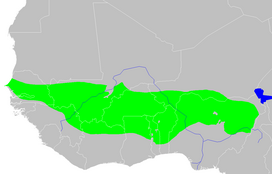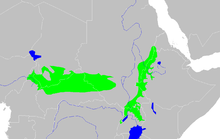Sudan (region)
| Sudan بِلَادُ السُّوْدَان | |
|---|---|
 An open hay landscape in the northern Gambia | |
 | |
| Ecology | |
| Borders | Sahara |
| Geography | |
| Rivers | Chari, Niger, and the White Nile |
Sudan is the geographical region to the south of the Sahara, stretching from Western Africa to Central and Eastern Africa. The name derives from the Arabic bilād as-sūdān (بلاد السودان) and arḍ as-sūdān (أَرْض السودان), both meaning "the lands of the Black [Africans]", referring to West Africa and northern Central Africa.[1]

History
[edit]According to some modern historians, of all the regions of Africa, western Sudan "is the one that has seen the longest development of agriculture, of markets and long-distance trade, and of complex political systems." It is also the first region "south of the Sahara where African Islam took root and flowered."[2]
Middle Ages
[edit]Its medieval history is marked by the caravan trade.[3] The sultanates of eastern Sudan were Darfur, Bagirmi, Sennar and Wadai. In central Sudan, Kanem–Bornu Empire and the Hausa Kingdoms. To the west were Wagadou, Manden, Songhay and the Mossi. [4][5]
Slave trade
[edit]Early on in the first millennium, many people from the Sudan were used as "a steady stream of slaves for the Mediterranean world" in the Saharan slave trade. With the arrival of the Portuguese in the fifteenth century, "people were directed to the Atlantic slave trade," totaling over a thousand years for the Saharan and four centuries for the Atlantic trades. As a result, slavery critically shaped the institutions and systems of the Sudan. The Portuguese first arrived at Senegambia and found that slavery was "well established" in the region, used to "feed the courts of coastal kings as it was used in the medieval empires of the interior." Between the process of capture, enslavement, and "incorporation into a new community, the slave had neither rights nor any social identity." As a result, the identity of people who were enslaved "came from membership in a corporate group, usually based on kinship."[6]
See also
[edit]Notes
[edit]- ^ International Association for the History of Religions (1959), Numen, Leiden: EJ Brill, p. 131,
West Africa may be taken as the country stretching from Senegal in the west, to the Cameroons in the east; sometimes it has been called the central and western Sudan, the Bilad as-Sūdan, 'Land of the Blacks', of the Arabs
. - ^ Klein 1998, p. 1.
- ^ Encyclopaedia of Islam IX. pp. 752, 758.
- ^ Encyclopedia of African History and Culture, volume II. New York: Facts on File, 2005. 2005. p. 211. ISBN 0-8160-5270-0.
- ^ Gale. New Encyclopedia of Africa, volume 4. Farmington Hills. pp. 752, 758. ISBN 978-0-684-31458-7.
- ^ Klein 1998, p. 1-2.
References
[edit]- Klein, Martin A. (1998). Slavery and Colonial Rule in French West Africa. Cambridge University Press.
- Reader's Digest: Atlas of the World (1991), Rand-McNally, ISBN 0-276-42001-2.
